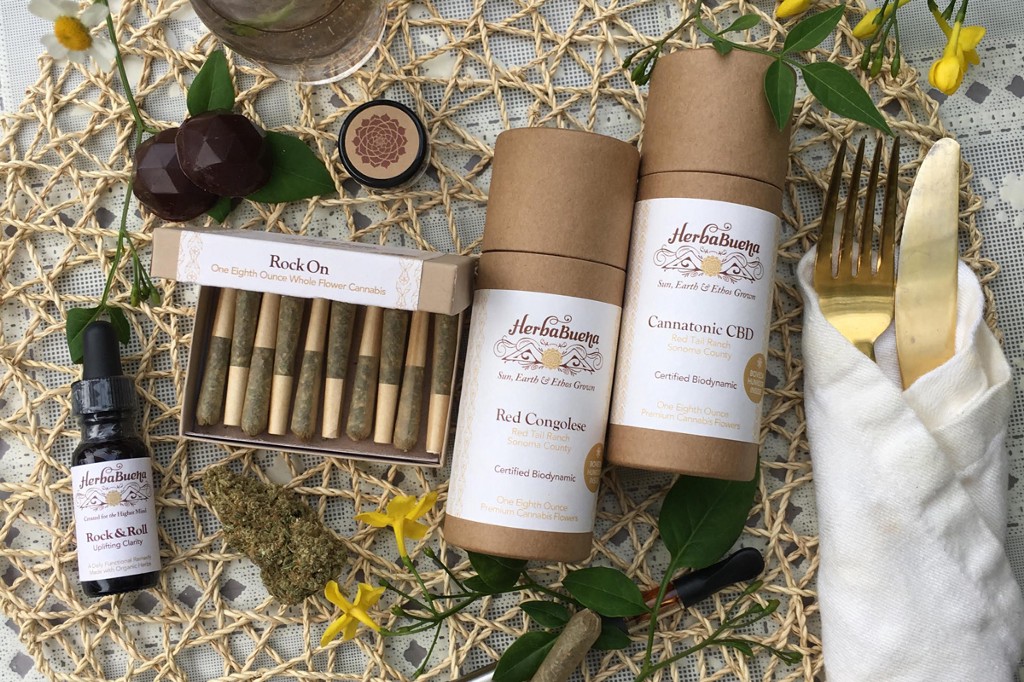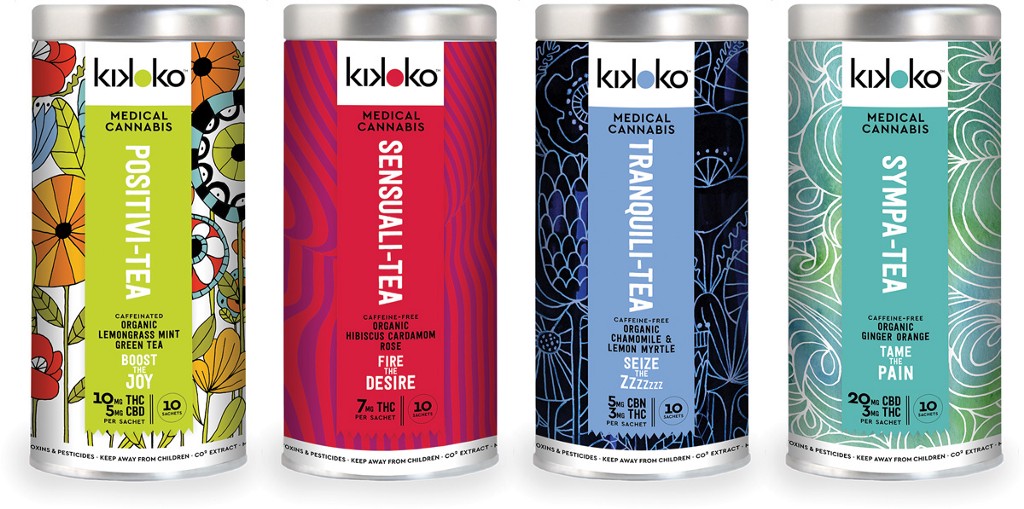Pot is being packaged like fine wines and sold with bold claims about physical and psychological benefits. Does science back up the marketing pitch?
In the back yard of the Wu Wei Tea Temple, a café in Fairfax, California, Brant Hindman, operations director of a new cannabis social club, HerbaBuena, held court with patrons in their 40s and 50s on a Saturday afternoon. He stood behind a table filled with biodynamic, sun-grown cannabis flowers on display under glass bell jars, each with a description written like wine-tasting notes on fancy cards: “amazing balance of THC to CDB,” “pain-easing” and “bright high.”
Hindman, tall with a shaved head, laughed and half jokingly called himself a “sensimelier” as he advised the club’s members toward the flower “with fruit in the terpenes” or the one with “a more earthly, marigold nose.”
“When your brain is somehow deficient in some kind of cannabinoid, when you smell it or taste it, you’ll get a sense of whether it’s the right cannabinoid for you or not,” he said. “Say, you’re leaning towards ‘Ooh, tangy, this is the right thing for me. It works for my anxiety.’ If your body leans in or leans out, you’ll get a good sense of whether it’s the right strain for you.”
This is a new way of selling pot. Not only is the artisanal texture of HerbaBuena’s spiel familiar to wine aficionados, it’s also sprinkled with claims that certain chemical compounds in the plant — especially cannabidiol, or CBD — are just what your body needs for improving your sleep, your mood and other aspects of your health. Yes, this sounds like what you’ve heard medicinal marijuana advocates touting for decades. But new research is beginning to support the idea that CBD is a key and underappreciated ingredient.
What makes CBD particularly intriguing as a potential health aid is that it doesn’t get you high. That effect primarily comes from THC, or delta-9-tetrahydrocannabinol. But while CBD can be distilled from pot, it’s not considered as effective when isolated from the other chemicals in the plant. (This is known as the “entourage effect.”) So growers are developing strains with higher CBD-to-THC ratios — and businesses like HerbaBuena are walking people through these new choices.

Wearing a belted sun dress, HerbaBuena founder Alicia Rose brushed her long honey brown hair back before leaning over a display of products inside the tea house, including micro-dosing tinctures, CBD-heavy chocolates and dried fruit edibles. She described the alchemy and effects of her different products to new members of the social club who sat along a counter. One member, Laura Bailey, told Rose that she had problems falling asleep. “Then you’ll want to keep this right by your bed,” Rose said, holding a small medicine jar with a dropper. “Along with organically grown cannabis, it has passionflower, hops, flower and gemstone essences, along with glycerin.”
“I think I also want to take this before yoga class,” Bailey responded. She held up a box of OARA CBD chocolates. The label announced “hand poured, couverture dark chocolate, infused with biodynamic sun-grown cannabis and a daily probiotic.”
“That’s a good choice,” Rose said.
It’s no accident that HerbaBuena’s potions, blends, tinctures, patches, gels and even sprays for pets that suffer from anxiety are beautifully packaged like high-end wine or gourmet food. Rose was raised on a farm in New York by hippie parents who grew their own marijuana, but she spent the last 15 years as a marketing and branding consultant at boutique California wineries. And just as most people don’t buy a high-end Napa cabernet to get drunk, she’s predicting that many adults want the medical benefits of cannabis without intense highs.
The science behind the chemical compounds in cannabis is far more complex than in wine and still emerging. But studies at Harvard Medical School have indicated that CBD might improve some people’s ability to solve problems in addition to improving sleep and overall quality of life.
Much of this research has come from Staci Gruber, an associate professor of psychiatry at Harvard who has been studying the effects of cannabis for about two decades and founded Marijuana Investigations for Neuroscientific Discovery (MIND) at McLean Hospital. Gruber and other researchers have found that when kids use cannabis prior to age 16, when their brains are still developing and more vulnerable, it can have detrimental effects such as attention deficits, lower IQ scores and increased impulsivity. Perhaps tellingly, the cannabis smoked by young people is often developed for maximum psychoactive impact, so it contains very high levels of THC. In a study entitled “Splendor in the Grass?” she and her colleagues noted that THC levels in recreational marijuana rose from 4 percent to 12 percent between 1995 and 2014 while CBD levels in some strains were barely perceptible.
But Gruber has found very different results with adults who used medical cannabis that often had a higher ratio of CBD to THC. In one study, 11 medical marijuana users between the ages of 32 and 75 exhibited improvement on tasks mediated by the frontal cortex, which is responsible for problem solving. She says those results are holding up in experiments with larger sample sizes. And her team is finding that other cannabinoids, such as cannabichromene (CBC), cannabinol (CBN) and cannabigerol (CBG), deserve further examination as possible treatments for a wide range of ailments.
“This will be so very, very mild that my 81-year-old mother is looking forward to it.”
Amanda Jones Cofounder Kikoko Teas
The field has come a long way since Dr. Raphael Mechoulam, an Israeli biochemist, first discovered THC in the 1960s and then identified the endocannabinoid system — naturally occurring receptors for cannabis-like compounds our bodies naturally produce. One such compound found in the brain is anandamide. It’s been called “the bliss molecule” and appears to be stimulated by oxytocin, the “love hormone.” Julie Holland, a psychiatrist and the author of The Pot Book, calls anandamide “a molecule of resilience that helps you bounce back from stress.” And it follows, then, that “cannabinoids from the plant can augment the naturally occurring ones in our systems,” she says.
How does this work, exactly? Gregory Gerdeman, a neuroscientist at Eckerd College in Florida who wrote his dissertation on cannabis pharmacology, says endocannabinoids are like surge protectors for cells, helping to modulate their levels of electricity. Crucially, these receptors are found throughout the body, not only in the brain but also in the muscular, immune and reproductive systems. That’s why marijuana has shown promise for treating such a wide array of problems from depression and anorexia to Parkinson’s and multiple sclerosis.

Gerdeman hopes that cannabis research will eventually make it possible to isolate the different molecules in cannabis that best target the endocannabinoid system to treat specific illnesses. But for now this is still a bit of a guessing game on the part of cannabis farmers and lab scientists who are working with producers such as Kikoko Teas, founded in Sausalito, California, by Jennifer Chapin and Amanda Jones. This spring they are launching customized cannabis herbal teas. One called “Sympa-Tea,” a ginger-orange blend, has 20 milligrams of CBD and 3 of THC per tea bag. It’s intended to be used as a pain reliever.
Jones said that until recently, dispensaries wouldn’t be interested in these teas because of the low dosage of THC, but that’s beginning to change. “We are working on a tea that’s 80 parts CBD to 2 parts THC,” she says. “This will be so very, very mild that my 81-year-old mother is looking forward to it.”












